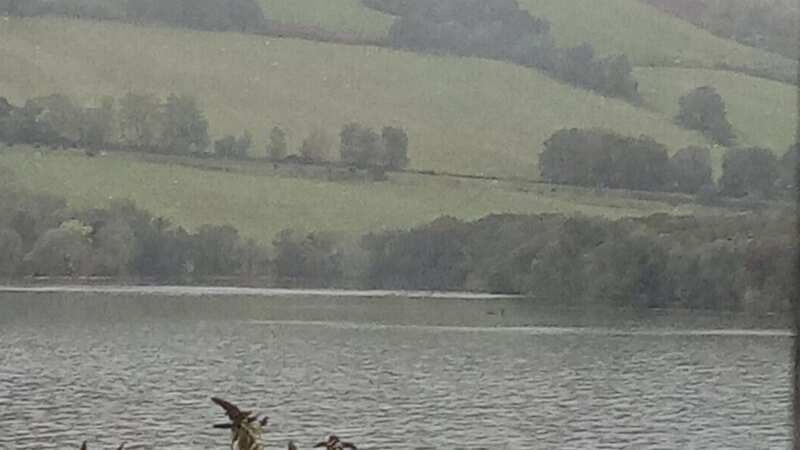Latest Loch Ness Monter sighting 'clearest yet' after first photo 90 years ago

It seems that the Scottish folklore tale of the Loch Ness Monster has been around forever. But the first known photo of the beast was only 90 years ago today, published in The Inverness Courier - where it was described as a large "beast" or "whale-like fish" rolling around in the water.
The sighting was caught by a couple who were driving along the A82 and since then the creature, nicknamed Nessie, has reached global attention. Its presence has even been recognised commercially in fiction books and films, such as Twilight: Breaking Dawn part two when Bella is angry her daughter's nickname is "after the Loch Ness monster."
Decades after the first official photo, the latest sighting of the spectacle came on October 8. John Howie took a picture of a Nessie-shaped figure before it disappeared into the water. He shared the image with The Loch Ness Centre, which said it is potentially the "clearest evidence" that the monster is real.
The shape, estimated to have been around 15ft long, was slowly moving towards the tree line, John said. He said he was able to snap some photos before the creature vanished into the depths of Loch Ness.
Loch Ness Centre General Manager Paul Nixon said: "At the Loch Ness Centre, we love hearing about these encounters with Nessie. It's a phenomenon boasting over 1,000 eyewitness accounts and recorded sightings, alongside lots of unexplained evidence.
 Furious chimp launches bottle at girl filming him leaving her bleeding at zoo
Furious chimp launches bottle at girl filming him leaving her bleeding at zoo
 The Loch Ness Centre said the latest sighting and John's photos are potentially the 'clearest evidence' of Nessie's existence (John Howie / Loch Ness Centre / SWNS)
The Loch Ness Centre said the latest sighting and John's photos are potentially the 'clearest evidence' of Nessie's existence (John Howie / Loch Ness Centre / SWNS)"At the Loch Ness Centre, guests can hear real people’s stories, discover artefacts, and listen to scientific debate on the existence of Nessie to help them make up their own mind on images such as this." A spokesman for the centre said: ''The Loch Ness Centre has recently reported a new sighting of Scotland’s beloved monster, which is possibly the clearest evidence this year of Nessie’s existence.
''Captured on Sunday 8th October at around 5pm, John Howie spotted something mysterious in the Loch, moving slowly towards the tree line before it disappeared and estimates it to be around 12-15 feet long!'' It marks the eighth high-profile Nessie sighting of 2023.
Loch Ness has topped the list of UK destinations that Brits are desperate to visit after a surge in interest in monster hunting. There have been seven recorded by the Official Loch Ness Monster Sightings Register already in 2023 - the same number of last year. Despite there being no solid evidence for Nessie's existence, there is clearly huge interest in the myth and a widespread desire to visit the beautiful lake.
 The latest sighting happened on October 8 (John Howie / Loch Ness Centre / SWNS)
The latest sighting happened on October 8 (John Howie / Loch Ness Centre / SWNS)Even if you are not inclined to believe old wives' tales, there is plenty to tempt you to Loch Ness. The mountains and hills that surround its shores are great for walks and are particularly beautiful when viewed from the water. At 23 miles long and 230m deep at its deepest, it is the lake with the largest volume anywhere in the country.
According to a survey of 2,000 people, Loch Ness is now top of Brits' travel bucket lists. The Scottish Highlands and Cornwall's Eden Project also made it into the top three in the poll. The iconic White Cliffs of Dover in Kent, the picturesque Scottish Coastline and London's Kew Gardens were also popular choices. The survey revealed that while many like familiarity when holidaying, a significant number are unsure of where to go or are afraid to try somewhere new.
Nearly a third (31 per cent) of Southerners have never been to Scotland, with 29 per cent of Northern residents never venturing as far south as Devon or Cornwall. The research was commissioned by London North Eastern Railway (LNER), which has launched an extended fourth version of its popular LNER Green Guide series, in partnership with Visit Kent, Southeastern, St. Pancras International and the King’s Cross Neighbourhood.
The latest version of the guide features eco-friendly tips for people looking to discover the best of the south and east Coasts of England and Scotland with the guide focusing on Leeds, Aberdeen, Canterbury, Folkestone, and the King's Cross St. Pancras area - all 'underdiscovered' gems.
The study also found that half (49 per cent) of Brits have three or more UK destinations on their bucket list. With Hadrian's Wall in Cumbria, Stonehenge in Salisbury, and London's Buckingham Palace also featuring on the nation's list of places they'd love to visit. Meanwhile, more than seven in 10 (73 per cent) of those likely to visit areas of the UK they've never seen before are planning a trip within the next 12 months.
Read more similar news:
Comments:
comments powered by Disqus

































